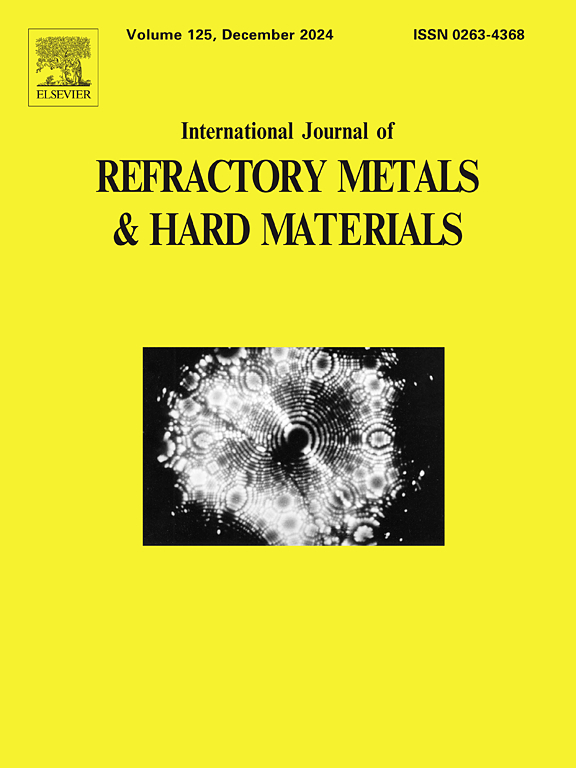添加B4C对激光熔敷Nb-16Si-20Ti合金组织和力学性能的影响
IF 4.2
2区 材料科学
Q2 MATERIALS SCIENCE, MULTIDISCIPLINARY
International Journal of Refractory Metals & Hard Materials
Pub Date : 2025-05-06
DOI:10.1016/j.ijrmhm.2025.107221
引用次数: 0
摘要
由于NbSi合金具有较低的室温断裂韧性和可加工性,因此在实际应用中遇到了困难。为了快速成形合金并提高其断裂韧性,本研究探讨了添加B4C对激光熔化沉积(LMD) Nb-16Si-20Ti合金组织和性能的影响。结果表明,与弧熔合金相比,LMDed合金的相对密度均在97.0%以上。lmd0b4c合金由Nbss、Nb3Si和Tiss相组成。随着B4C的加入从0增加到0.50 at。%时Nb3Si消失,发生共晶转变反应(Nb3Si→Nbss+ α-Nb5Si3), Nbss的体积分数由39.5%增加到50.3%。进一步增加B4C添加到1.0 at。%时,显微组织由Nbss+α-Nb5Si3共晶组织(未添加B4C)转变为细小的初生α-Nb5Si3和(Nbss+α-Nb5Si3)过共晶组织(所有α-Nb5Si3相的体积分数高达41.4%)。由于显微组织的细化和等轴晶Nbss中应力的各向同性,LMDed 1.0B4C在所有合金中具有最高的断裂韧性,为10.7 MPa·m1/2。同时,其室温抗压强度最高可达2203.3 MPa,这主要是由于Nb5Si3中碳、硼的晶粒细化强化和固溶强化作用,以及硅化物含量的增加(硅化物总体积分数为51.6%)。本文章由计算机程序翻译,如有差异,请以英文原文为准。
Effects of B4C addition on microstructure and mechanical properties of Nb-16Si-20Ti alloys fabricated by laser melting deposition
Practical applications for Nb![]() Si alloys encountered difficulties because of their low room temperature fracture toughness and machinability. To achieve rapid alloy formation and enhance its fracture toughness, this study explored the effect of B4C additions on the microstructure and properties of Nb-16Si-20Ti alloy formed by Laser Melting Deposition (LMD). The results showed that the relative densities of LMDed alloys were all more than 97.0 % compared with arc melting alloys. The LMDed 0B4C alloy consisted of Nbss, Nb3Si, and Tiss phases. With the addition of B4C increased from 0 to 0.50 at. %, Nb3Si disappeared, a eutectic transformation reaction (Nb3Si → Nbss+ α-Nb5Si3) occurred, resulting in an increase in the volume fraction of Nbss from 39.5 % to 50.3 %. Further increased the B4C addition to 1.0 at. %, the microstructure transitioned from a Nbss+ α-Nb5Si3 eutectic structure (without B4C addition) to a fine primary α-Nb5Si3 and (Nbss+α-Nb5Si3) hypereutectic structure (with volume fraction of all α-Nb5Si3 phases up to 41.4 %). The LMDed 1.0B4C exhibited the highest fracture toughness of 10.7 MPa·m1/2 among all alloys due to the refinement of the microstructure and the isotropic of the stresses in the equiaxed crystal Nbss. Meanwhile, its compressive strength at room temperature reached a maximum of 2203.3 MPa, a result attributed to the grain refinement strengthening, solid solution strengthening effect of carbon and boron in Nb5Si3, and the increase in silicide content (with a total volume fraction of silicide phases at 51.6 %).
Si alloys encountered difficulties because of their low room temperature fracture toughness and machinability. To achieve rapid alloy formation and enhance its fracture toughness, this study explored the effect of B4C additions on the microstructure and properties of Nb-16Si-20Ti alloy formed by Laser Melting Deposition (LMD). The results showed that the relative densities of LMDed alloys were all more than 97.0 % compared with arc melting alloys. The LMDed 0B4C alloy consisted of Nbss, Nb3Si, and Tiss phases. With the addition of B4C increased from 0 to 0.50 at. %, Nb3Si disappeared, a eutectic transformation reaction (Nb3Si → Nbss+ α-Nb5Si3) occurred, resulting in an increase in the volume fraction of Nbss from 39.5 % to 50.3 %. Further increased the B4C addition to 1.0 at. %, the microstructure transitioned from a Nbss+ α-Nb5Si3 eutectic structure (without B4C addition) to a fine primary α-Nb5Si3 and (Nbss+α-Nb5Si3) hypereutectic structure (with volume fraction of all α-Nb5Si3 phases up to 41.4 %). The LMDed 1.0B4C exhibited the highest fracture toughness of 10.7 MPa·m1/2 among all alloys due to the refinement of the microstructure and the isotropic of the stresses in the equiaxed crystal Nbss. Meanwhile, its compressive strength at room temperature reached a maximum of 2203.3 MPa, a result attributed to the grain refinement strengthening, solid solution strengthening effect of carbon and boron in Nb5Si3, and the increase in silicide content (with a total volume fraction of silicide phases at 51.6 %).
求助全文
通过发布文献求助,成功后即可免费获取论文全文。
去求助
来源期刊
CiteScore
7.00
自引率
13.90%
发文量
236
审稿时长
35 days
期刊介绍:
The International Journal of Refractory Metals and Hard Materials (IJRMHM) publishes original research articles concerned with all aspects of refractory metals and hard materials. Refractory metals are defined as metals with melting points higher than 1800 °C. These are tungsten, molybdenum, chromium, tantalum, niobium, hafnium, and rhenium, as well as many compounds and alloys based thereupon. Hard materials that are included in the scope of this journal are defined as materials with hardness values higher than 1000 kg/mm2, primarily intended for applications as manufacturing tools or wear resistant components in mechanical systems. Thus they encompass carbides, nitrides and borides of metals, and related compounds. A special focus of this journal is put on the family of hardmetals, which is also known as cemented tungsten carbide, and cermets which are based on titanium carbide and carbonitrides with or without a metal binder. Ceramics and superhard materials including diamond and cubic boron nitride may also be accepted provided the subject material is presented as hard materials as defined above.

 求助内容:
求助内容: 应助结果提醒方式:
应助结果提醒方式:


